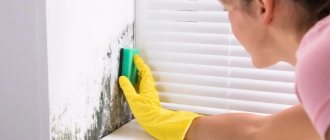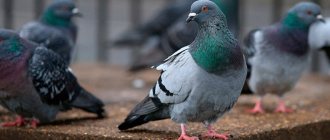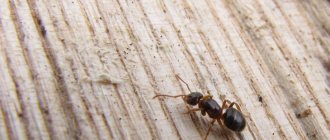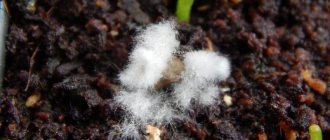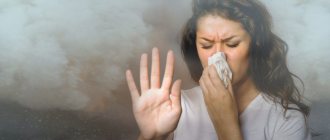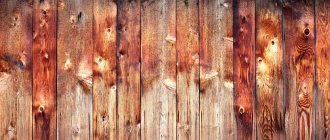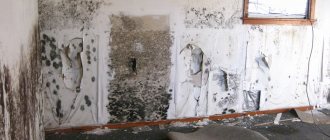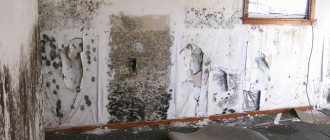Since ancient times, people have always shared their homes with other inhabitants of the animal and plant world: even in modern high-rise buildings, mice, spiders, cockroaches, bedbugs and various small animals are found every now and then. But if a person can put up with some illegal tenants and not pay attention to them, then living next to others is dangerous to life and health.
Enemy number one is mold stains in living spaces. These black and greenish-brown spots do not bite anyone, but it becomes impossible to live in the house. In addition, sometimes a fungal colony can camouflage itself and live on the back side of the wallpaper for years, without external manifestations, gradually growing and capturing new territories. So, what to do if mold appears under the wallpaper? How to deal with it? And is it possible to win this war alone?
What is mold and its harm to humans?
Mold is a colony of toxic single-celled fungi. Their spores are extremely dangerous to human life and health. Once in a favorable environment (optimal conditions: absence of light, oxygen flow, high humidity), the spores multiply very quickly and enter the human body by air, provoking:
- a sharp deterioration in general health;
- constant headaches;
- development of acute allergic reactions;
- decreased human immunity;
- the appearance of diseases of the respiratory system.
Pregnant women, young children and people with weakened immune systems are most at risk.
Harm of fungus to health
You can recognize the appearance of fungal colonies in the house by a persistent characteristic odor. Just the sight of unattractive stains on wallpaper causes disgust. You have to completely forget about comfort, since even your clothes are covered with a grayish coating.
When a favorable environment arises in the apartment, several types of fungus appear:
- Green mold forms more often than others and is easy to wash off and destroy.
- Colonies have a dark green tint, which are more difficult to remove, but if you wash them immediately after detection, they do not cause problems.
- The white fungal colony resembles fluff in appearance. Its spores spread very quickly throughout the house and are harmful to health. Such moldy stains can be removed only with a respirator and gloves.
- Black fungal spots weaken human immunity. They cover large areas in a short time. To remove them you need special chemicals.
Important! If more than 20% of the wall surface is affected by fungal colonies, the dwelling is considered dangerous and is considered unsuitable for people and animals to live in.
Mold fungi are dangerous for humans because they provoke allergy attacks, cause dermatological and dental diseases, conjunctivitis and a strong, suffocating cough. Penetrating into the body, mold spores settle on the mucous membranes of the respiratory organs and cause serious illnesses. Long-term living in an apartment contaminated with mold is especially dangerous for children and the elderly. Such proximity causes exacerbation of chronic diseases and becomes the cause of other diseases.
Reasons for appearance
Factors contributing to the development of mold fungi:
- High humidity.
- Lack of ventilation. The lack of fresh air flow (hermetically sealed windows) creates a favorable environment for the development of pathogenic microorganisms.
- Furniture moved close to the walls disrupts natural air circulation.
- Lack of insulation (sharp temperature difference in the wall). Violations of the construction process, insufficient waterproofing of floors (and sometimes its complete absence) lead to sharp temperature changes in the wall in the autumn-winter period, which has a beneficial effect on the proliferation of mold fungi.
- The influence of dampness from the basement or poor insulation on the roof. For residents of the first and last floors of apartment buildings, the problem of mold is known. This is because leaking floors, roofs, and damp basements are an ideal environment (damp and dark) for the growth of mold fungi.
Causes of black fungus in residential areas
Before removing fungus from the walls, it is necessary to find out the reasons for its formation, thanks to which it will be possible to completely eliminate fungal spores. Basically, the source lies in two things - moisture and insufficient ventilation, which occurs due to a number of the following circumstances:
- The premises are equipped with metal-plastic windows, the design of which excludes the flow of fresh air. If they do not have a special forced ventilation system, then rooms with them need regular ventilation.
- Location of premises on the first floor. In this case, the fungus first attacks the joints of the walls, after which mold appears directly under the wallpaper itself. The reason is that below are the basements, which are often flooded and have moisture levels that are significantly higher than optimal.
- Roof leaking when living on the top floor. If the building is panel, then moisture can spread along the joints of the floors below.
- The waterproofing of interpanel seams and external walls was not done well enough. In this case, black dots on the wallpaper begin to appear when the first cold snap sets in, when the heating system in the room is not yet working, and it is cool outside and it often rains.
- Renovation work on the house was only recently completed, and after finishing work, a large amount of moisture remained in the premises. In such a situation, the repairs should be completed before the onset of autumn or the walls should be covered with wallpaper after the heating is turned on.
- The first appearance of fungus in the bathroom. Basically, in these rooms there is not only increased dampness, but also heat, and ventilation is not good enough, without which, after some time, mold will inevitably form.
- The presence of a large number of indoor plants on window sills that need regular watering, which causes increased dampness in the room.
- Excessive use of humidifiers.
In addition, the reason may be a flood, which could have occurred among neighbors living on the floor above. Water might not have reached the interior of the room, but the walls were saturated with moisture and you may not even suspect it, just like what caused the fungus to appear.
Mold under wallpaper after renovation
There are several reasons why mold fungi appear immediately after repairs:
- Use of low-quality, already contaminated building materials. Most often these are sheets of plasterboard, the layered structure of which perfectly preserves pathogenic microorganisms.
- Installation of super-tight metal-plastic window blocks.
- Mistakes made by craftsmen during repairs. So, by gluing new wallpaper onto damp plaster or putty, after a while you can find fresh traces of mold on the decorative wall.
Preparing the premises
Before you begin operations with wallpaper and walls where mold is impatiently waiting for you, you must:
- we remove all furniture from the affected room, it is recommended to wipe it with a damp cloth moistened with alcohol or saline solution;
- We place pieces of loose plaster with wallpaper in sealed bags and immediately take them to the trash;
- After cleaning work, we moisten the walls again with a rag with alcohol or any other solution that contains substances that are dangerous for mold.
How to stop the spread
You can stop the development of mold colonies:
- saturating the room with sunlight and air;
- installing a forced ventilation system;
- providing an influx of warm, dry air (temperature 20-23C). Electric heating devices will come to the rescue;
- Having eliminated sources of dampness, carry out wet cleaning more often using antibacterial drugs.
Mold in the washing machine: diagnosis or death sentence?
How to prevent further colony growth
So, mold was found under the wallpaper. What to do in this situation? The first steps should be aimed at preventing further growth of the colony. Any methods to reduce humidity and additional ventilation can be used:
- open the window;
- install a fan;
- turn on the heater in the room;
- remove all sources of dampness - laundry, flowers in pots, fix dripping faucets or pipes, etc.;
- Shine the wall with a UV lamp, as its radiation is harmful to fungi.
Mandatory protective equipment
When treating surfaces with antibacterial drugs, it is very important to use personal protective equipment:
- specialized clothing (robe, overalls);
- respirator (protects the respiratory system);
- special glasses;
- latex gloves.
When cleaning walls, ceilings, and floors, it is important to ensure that the room is well ventilated. It is necessary to avoid contact of antiseptics and antifungal drugs with the skin. After finishing work, be sure to take a shower.
Cleaning surfaces from mold using industrial and household preparations
Complete mold removal involves the following measures:
- Remove the affected wallpaper partially or completely. If the problem is global, complete dismantling will be required.
- For high-quality cleaning, it is worth stripping the primer layer. To do this, use a spatula and remove the layer of construction mixture.
- Surface treatment with disinfectants. Products can be bought in specialized stores or made independently.
- To prevent the return of mold, it is worth treating the surface with a special antiseptic, which can be purchased at a hardware store. You should act according to the instructions indicated on the antiseptic drug.
- At the end of the operations, dry the wall, apply a primer and cover it with new wallpaper.
Industrial anti-mold products
The modern market presents an impressive range of chemical preparations for mold. You can buy a high-quality fungicide in regular chemical stores.
As a rule, in any city, at the sanitary and epidemiological station, there are stores that sell high-quality chemicals - professional and effective drugs to solve the problem.
How to detect mold under wallpaper
Mold colonies appear very quickly. The first signs that fungal spores are growing under the wallpaper will be small black spots on the surface. Most often they can be seen in corners, on the wall behind furniture.
In the room where mold fungi develop, there is a rather persistent, very unpleasant smell of mustiness and dampness. Upon entering, you feel like you are entering a basement.
Mold on the wall
Mold appears on the wall under the wallpaper for exactly the same reasons as in other places. People are often outraged that fungi appear unexpectedly. For example, for 10 years everything was normal, but then after the renovation this fluffy infection appeared. What happened?
Only the homeowner can answer this question. Maybe he installed plastic windows and combined the kitchen with the room, which is why the living room was left without ventilation. Meanwhile, children's clothes are constantly being dried in this room.
Or, during the repair, he did not insulate the constantly freezing corner, but it began to freeze even more, which led to condensation and constant dampness. And as a result, to mold.
How to deal with large-scale pollution
When mold has grown not only into the wallpaper, but also into the layer of plaster, following a clear algorithm of actions will help eliminate the problem.
Removing wallpaper
Rip off contaminated coverings ruthlessly. If fungi have grown into the layer of plaster, hopes that black stains from the wallpaper can be removed with a damp cloth are in vain.
Mechanical cleaning of walls
Using a spatula, remove the layer of plaster under those parts of the decorative coating that have become infected.
Treatment of walls with construction chemicals against fungus
There is a fairly wide selection of anti-mold drugs available to the consumer (Fitoline, Xiolate). Having chosen the most suitable composition for yourself, the product is diluted with water according to the manufacturer’s instructions and the affected areas of the decorative coating are treated. Experts recommend re-treatment no earlier than six hours after the first.
Subsequent treatment of walls with antiseptics
Upon completion of treatment with an antifungal solution, the wallpaper is additionally coated with special antiseptic agents. They are presented to the consumer in a large assortment, and there is no need to breed them. An antiseptic prevents the appearance of fungus.
Puttying walls and wallpapering
After the dark spots of mold have been removed, you can begin decorating the surface. First, it is treated with finishing putty, and then covered with new wallpaper.
Assessing the scale of infection
The first step is a thorough inspection of the apartment. It is necessary to understand the reasons and assess the scale of the infection. Fungal infections can occur on both a local and global scale.
If the fungus has affected a small area, a high-quality treatment of the affected areas may be sufficient. If mold has spread over a large area, local repairs will have to be carried out using chemicals. If more than 20% of the wallpaper is damaged, drastic measures cannot be avoided. You may need to contact a specialist.
It is very important to eliminate the causes of fungal development, otherwise all subsequent operations will give only temporary results.
How to remove local manifestations of mold
You can quickly and effectively remove local foci of mold fungi by following a clear algorithm of actions:
- Determine the location of mold fungi.
- Wipe the infected area of the wallpaper with a damp sponge.
- Treat dark spots with hydrogen peroxide or diluted sting solution.
- Dry the treated area of wallpaper very well.
- Carry out wet cleaning in the room, treat the infected area with an ultraviolet lamp.
- Check ventilation. Move the furniture slightly away from the wall.
Fungus in the bathroom - causes, consequences and solutions
Ways to stop the infection
After detecting mold and finding out the cause of its appearance, it is important to create conditions in the apartment that are unsuitable for further growth of the fungus. Otherwise, all measures taken to combat the colony will be useless.
You need to follow these steps to ensure that the fungus under the wallpaper no longer spreads:
- They get rid of all sources of dampness: hang wet laundry to dry on the balcony or outside, eliminate all faults in the plumbing, and install an extractor hood in the kitchen.
- In the summer, open all the windows in the house completely to let in more fresh air and sunlight. In winter, to improve circulation, install a fan in the bathroom that sucks in moist air.
- Warm up fungus-infected areas on the wallpaper with a quartz or ultraviolet lamp.
- They dry the air in the room with heaters and a hair dryer to reduce humidity and create a temperature that is destructive for mold.
Important! Only after creating harmful conditions for mold in the apartment do they begin work to eliminate it.
Folk remedies
There are a sufficient number of folk remedies that help quickly remove the fungus:
- Copper sulfate. To treat the damaged area, prepare a solution at the rate of 5 liters of water, 50g. copper sulfate. Thoroughly stir the resulting solution, and use a roller to very carefully treat the surface area contaminated with mold.
- Chlorine-based bleaches. The main active ingredient in bleach, sodium hydrochloride, is the worst enemy and killer of mold spores. Important: chlorine is a highly toxic substance. You can work with bleach only in a well-ventilated area, using personal protective equipment (gloves, respirator). For treatment, use a solution prepared at the rate of five liters of water and half a liter of bleach. The product is applied with a roller or stiff brush.
- Laundry soap is effective when the fungus is just beginning to germinate. To treat damaged areas, rub a bar of soap and dissolve it in 10 liters of warm water. A strong soap solution is applied to the wall and allowed to dry thoroughly. The treatment is repeated several times.
- Vinegar is a non-toxic remedy for fighting mold spores. Vinegar is sprayed onto the wall, and then the loose layer of mold is scraped off with a spatula. It is necessary to wear a respirator when working with vinegar, as its smell is very strong and unpleasant.
- Baking soda combined with vinegar gives an excellent result for combating mold damage. Soda is diluted with vinegar to form a paste or slurry. The resulting product is used to treat the required area until the black spots disappear.
- Borax (also known as sodium tetraborate) is non-toxic and most effective for combating mold. To prepare the product, dissolve a glass of borax powder in three liters of water. The solution is applied to the surface with a stiff brush, simultaneously removing the visible black layer of fungus.
- Ammonia or ammonium hydroxide. Water and ammonia are poured into the sprayer (ratio one to one). The resulting product is thoroughly sprayed over the infected surface. After an hour, when the wall is completely dry, the treatment can be repeated. Important: ammonia emits a pungent, toxic odor. It is necessary to work with this product using a respirator.
- Hydrogen peroxide is an effective, non-toxic drug in the fight against mold. Apply peroxide, without diluting, to the damaged area and leave until completely dry. The treatment is repeated several times. Attention: hydrogen peroxide whitens surfaces well. Do not use it on unstable painted surfaces
- Tea tree oil has unique antibacterial and antifungal properties. Dissolve a few drops of tea tree oil in 250 ml of water. The resulting mixture is sprayed onto the stain.
- A UV lamp is effective for the initial manifestations of mold infection, as well as for prevention purposes. The treatment time for the damaged area is 10-15 minutes.
FAQ
Is it possible to clean fungal stains without removing the wallpaper?
It is possible to remove plaque from the surface, but this is just the tip of the iceberg. Disputes will remain, which means that in the near future the situation will repeat itself. The problem must be solved radically.
If the wallpaper is too expensive, is it possible to carefully remove the fungus from both sides, dry it and re-glue it in its original place?
It is impossible to destroy small spores, so this procedure will not solve the problem.
Is it possible to fight mold if there is only one room and there is nowhere to move?
It is possible, but you need to open the window, and also temporarily move the residents to the kitchen or another room until the wall dries out.
There is no visible mold, but the smell from the wallpaper is musty. Could this indicate that black spots will appear on the surface in the near future?
The fungus, if the wallpaper is too thick, can actively develop without visual manifestations. In places with the most fetid odor, you need to remove some of the wallpaper and examine the situation.
In conclusion, it is worth saying that it is easier to prevent the appearance of a fungus than to then waste time and effort fighting it. It is extremely important to control the humidity in the room, as well as periodically ventilate. It has been proven that there is practically no fungus in rooms where split systems are installed.
Store products
Top most effective store-bought anti-mold medications:
- Dali (Russia). Available in 5 liter containers. The product is intended for treating any surface. Dali is a universal remedy, effective not only against mold fungi, but also against moss and other manifestations of dampness.
- Fongiflud Alpa (Russia) is produced in containers of 2, 5, 20 liters. The product is intended for treating surfaces against fungus inside the house, from the facade. The drug retains its antiseptic properties even at low temperatures.
- Olympus stop mold (Russia) is an ideal remedy for fungus and mold spores affecting the surfaces of bathrooms, living quarters, basements, cellars. The product is suitable for treating any surface.
- Biotol spray is an environmentally friendly antiseptic. Non-toxic, safe for residential use.
- Ftlas mykos (Poland). The main active ingredient is ammonia. The drug is effective in combating mold spores and perfectly removes damp stains.
Getting rid of mold in the bathroom forever
Why is mold harmful?
Molds can trigger the development of allergies, suppress the body's immune system, and also become the root cause of more serious diseases. If a person has chronic diseases, under the influence of the fungus they can manifest themselves in a more acute form.
In addition, this spoils the aesthetic appearance of the room and also gives it a characteristic unpleasant odor. Sometimes mold gets on clothes and things, leaving grayish stains that are difficult to remove. Houses and apartments where mold is localized over a large area of walls and ceilings are considered uninhabitable.
How to remove mold without tearing off wallpaper
The need to remove wallpaper in order to remove mold is easy to determine. Tear up a small section of the wallpaper and carefully inspect the wall underneath. If the plaster is dry and light-colored, then mold fungi can be removed without removing the wallpaper.
Wallpaper paper
Removing mold from paper wallpaper is a labor-intensive and troublesome task. Under no circumstances should they be wet. A soft brush, a hairdryer, and a lot of patience will help remove dark spots.
Dry the wallpaper and carefully remove the stain with a soft brush.
Non-woven, acrylic, washable, vinyl wallpaper
This type of wallpaper is characterized by good resistance to moisture and abrasion. You can clean dark stains from such surfaces using any chemical or folk remedies.
When is a specialist needed?
It also happens that the wallpaper has to be changed monthly, but the fungus literally does not want to go away, although the products were chosen correctly and the microclimate is within normal limits. If you are tired of the unequal struggle, then do the following:
We call disinfectants - the services will help you quickly treat the walls with special fungicidal solutions that will completely destroy all mushrooms and their spores.- We clear the territory - we take out the furniture and decor, and move to another room.
- We are happy with the result - the next day you can begin the final stage of cleaning, and after a couple of days you can start gluing wallpaper.
Disinfector services are more effective, but they cost money. It is best to use them when the available means have stopped working, and fungal infections have begun to spread to other areas of the walls.
When you can't handle it on your own
In a situation where time is lost, mold fungi have managed to grow, penetrate the plaster and begin to destroy the brickwork, it will no longer be possible to eliminate the problem on your own. The solution will be major repairs or disinfection carried out by SES specialists.
Professional disinfectors use a whole range of techniques: gas treatment, cleaning surfaces with cold or hot steam. Special devices - thermal imagers - help to accurately diagnose the degree of damage by mold spores.
In what cases is it necessary to call the SES?
If you don't get rid of mold as soon as it appears on the wallpaper, over time it will grow so strong that it will penetrate the plaster and begin to destroy the brick wall. In this case, you will have to make major repairs to stop the spread of fungus and save the wall from infection. In this case, you can try to carry out disinfection on your own, but it is better to call the experts of the SES (Sanitary and Epidemiological Station).
They will cope with the task using a whole range of measures. This includes mechanical cleaning of contaminated surfaces, treatment with gas, cold and hot fog, as well as impregnation of walls with various professional antiseptic substances. In order to detect the area with the highest level of infection, special devices are used - thermal imagers. The processing process itself does not take very long, about two hours. Typically, the disinfection company provides a 3-year guarantee that mold will not appear in the room.
This service will cost 1,100 - 3,300 rubles. per sq.m. It’s not so cheap, especially if the amount of work is large, but you will be completely confident that the room has been treated with high quality and mold will no longer bother you in the near future.
What to do to prevent mold from occurring again
You can prevent the appearance and growth of mold fungi by creating a certain microclimate and following certain rules:
- check the ventilation system regularly;
- if necessary, install a forced ventilation system;
- During the day, open the curtain to let in ultraviolet rays;
- do not close the door to the bathroom (provided there are no people there);
- never dry clothes in living rooms;
- When cooking, turn on the hood and open the window;
- monitor the serviceability of plumbing fixtures;
- ruthlessly throw away things contaminated with mold spores;
- ventilate the apartment regularly;
- think over a competent home insulation system.
Removing mold from wallpaper is difficult, but possible, subject to timely reaction and knowledge of the most effective methods for solving the problem.
Prevention of mold formation
Preventing the development of mold is easier than fighting it. To prevent fungus on wallpaper, you should follow a number of rules:
Ventilation of premises
- when carrying out the first repair, insulate the walls if necessary;
- during the next repair, before pasting, treat the working surface with preventive compounds;
- inspect corners, joints and slopes for the presence of mold and remove the fungus that has already appeared, leaving it no chance for further development under the wallpaper;
- do not allow excess humidity - if the room is flooded, promptly dry the walls and then spray them with special antifungal agents;
- ventilate the room and create drafts as often as possible;
- open the curtains over the entire window opening at least once a day, preferably for several hours - sunlight suppresses the fungus;
- do not move furniture too close to the walls - there should be a gap of 5 centimeters or more for air circulation;
- light scented candles from time to time - essential oils of lemon, orange, bergamot have fungicide properties.
The list is not exhaustive.
Important! If the apartment is “problematic” and is subject to periodic fungal invasions, it is necessary to identify and eliminate the root cause, otherwise treatment measures will become a lifelong responsibility for the homeowners.
